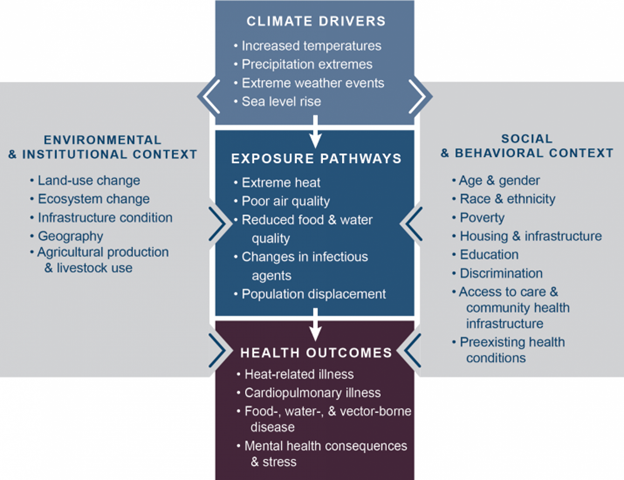Online Undergraduate Course
Nurs 467 - Public Health Nursing
Module 11: Environmental Health and Emergency Preparedness
Climate Change

The rise in Earth’s temperature, resulting from emissions and elevated concentrations of greenhouse gases in the atmosphere, is contributing to a changing climate. Human activity, such as burning fossil fuels for energy production and use, transportation, industry (including healthcare), and agriculture have resulted in unprecedented levels of greenhouse gas emissions such as methane, carbon dioxide, and nitrous oxide. The science is clear that human activity is the dominant cause of Earth’s rising temperature and without immediate action irreversible damage is likely.
As a result of rising temperatures, changing and variable weather patterns are occurring, such as extreme temperatures both heat and cold, rising sea levels from melting of snow and ice, changes in precipitation resulting in flooding and drought, more intense hurricanes and storms, stronger and more frequent wildfires, as well as poor air quality. Changes to climate patterns lead to direct and indirect threats to public and environmental health. (ANHE 2022)
This can occur in two main ways: first, by changing the severity or frequency of health problems that are already affected by climate or weather factors; and second, by creating unprecedented or unanticipated health problems or health threats in places where they have not previously occurred. (US Global Change Research Program Climate and Health Assessment 2016

Vulnerable Populations to Climate Change

Health Care’s Impact on Climate Change
The health care sector has a significant climate impact, producing nearly 10% of the total greenhouse gases in the United States. If the U.S. health care sector were itself a country, it would rank 13th in the world for emissions, ahead of the entire United Kingdom.
Hospitals are among the most energy-intensive buildings in the country, consuming more than 10% of the total energy used in commercial buildings and spending more than $8 billion on energy every year. That’s enough to cover the average salary of more than 100,000 nurses.
Nurses’ Role in Climate-smart Health Care
With support and guidance from Practice Greenhealth, and Health Care Without Harm hospitals and health systems across the country are addressing climate change as a public health issue by reducing their carbon footprint, transitioning to clean, renewable energy, and building climate-resilient facilities. As the nation’s most trusted professionals, nurses are powerful advocates for climate solutions and have a tremendous opportunity to protect their patients from the impacts of climate change by working to create sustainable, climate-smart hospitals and health systems.
As the nation’s only organization dedicated to bringing the nursing voice to environmental challenges, the Alliance of Nurses for Healthy Environments amplifies the professional imperative of caring for the environment and addressing climate change within the context of our health care system.
Climate Change Resources
- ANHE Climate Change
- Moving Forward: A Guide for Health Professionals to Build Momentum on Climate Action
- Advancing Clean Air, Climate, & Health: Opportunities for Nurses
- Nurses Climate Challenge
- CHANT Survey Climate, Health, and Nursing Tool is a 10-minute survey asking respondents about awareness, motivation, and behaviors related to climate change and health.
- Moms Clean Air Force brochure for health professionals
- WHO Climate Change and Health
- APHA Climate Change
- Intergovernmental Panel on Climate Change (IPCC)
- Lancet Countdown 2022 report
- Fourth National Climate Assessment
- Climate and Health Assessment
- White House National Climate Task Force
This website is maintained by the University of Maryland School of Nursing (UMSON) Office of Learning Technologies. The UMSON logo and all other contents of this website are the sole property of UMSON and may not be used for any purpose without prior written consent. Links to other websites do not constitute or imply an endorsement of those sites, their content, or their products and services. Please send comments, corrections, and link improvements to online@son.umaryland.edu.